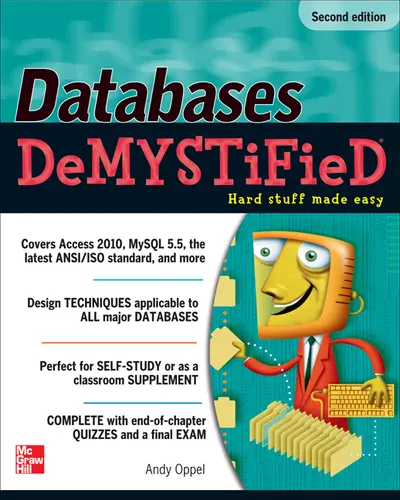My Account Details

ISBN10: 0071748008 | ISBN13: 9780071748001

Step 1 . Download Adobe Digital Editions to your PC or Mac desktop/laptop.
Step 2. Register and authorize your Adobe ID (optional). To access your eBook on multiple devices, first create an Adobe ID at account.adobe.com. Then, open Adobe Digital Editions, go to the Help menu, and select "Authorize Computer" to link your Adobe ID.
Step 3. Open Your eBook. Use Adobe Digital Editions to open the file. If the eBook doesn’t open, contact customer service for assistance.
Learning DATABASE fundamentals just got a whole lot EASIER!
Now you can design, build, and manage a fully functional database with ease. Thoroughly updated to cover the latest technologies and techniques, Databases Demystified, Second Edition gives you the hands-on help you need to get started.
Written in a step-by-step format, this practical guide covers methods that can be used with any database, including Microsoft Access, MySQL, Microsoft SQL Server, and Oracle. You'll learn about relational database components, database queries, SQL, the database life cycle, logical database design using normalization, and physical database design. Data and process modeling, database security, Online Analytical Processing (OLAP), and XML are also covered. Detailed examples and concise explanations make it easy to understand the material, and end-of-chapter quizzes and a final exam help reinforce learning.
It's a no-brainer! You'll find out how to:
- Create and run database queries using the forms-based query tool in Microsoft Access
- Write SQL statements and queries
- Use entity relationship diagrams (ERDs) for data modeling
- Design physical tables
- Connect databases to users, computer systems, and applications
- Secure database data
- Handle cursor processing, transaction management, and performance tuning
- Integrate XML documents and objects into databases
Simple enough for a beginner, but challenging enough for an advanced student, Databases Demystified, Second Edition is your self-paced guide to learning universal database concepts.
Chapter 2. Exploring Relational Database Components
Chapter 3. Forms-Based Database Queries
Chapter 4. Introduction to SQL
Chapter 5. The Database Life Cycle
Chapter 6. Logical Database Design Using Normalization
Chapter 7. Data and Process Modeling
Chapter 8. Physical Database Design
Chapter 9. Connecting Databases to the Outside World
Chapter 10. Database Security
Chapter 11. Database Implementation
Chapter 12. Databases for Online Analytical Processing
Chapter 13. Integrating XML Documents and Objects into Databases
Need support? We're here to help - Get real-world support and resources every step of the way.